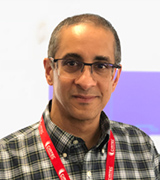Assistant: Sue Bedford
Phone: 519 931-5777 ext. 25244
Email: rmenon@uwo.ca
Ravi Menon

Co-Scientific Director BrainsCAN
Molecular Imaging
Why I Became a Scientist
My mother is an engineer and my father is an astronomer. So I had no choice ! I was always interested in why things work, both from the point of view of the little pieces that made up a piece of equipment as well as the laws of nature that governed its operation. I wanted to use my background in physics to do something of immediate benefit to mankind, so magnetic resonance imaging (MRI) seemed like the perfect place to hang my hat. I was encouraged by wonderful mentors (Alex Mackay, Peter Allen, Kamil Ugurbil and Seiji Ogawa) who always pushed me to tackle tough problems of biological relevance using my physics education. They are an enormous part of why I became and continued on as an academic scientist.
Research Summary
My research area lies in the development of technology for ultra high field functional magnetic resonance imaging (fMRI) as well as understanding what it measures and tells us about human brain function. Driven by neuroscience questions posed by our colleagues, we develop new hardware (such as new radio frequency coils) and software solutions (novel pulse sequences) for fMRI. We utilize MRI scanners at 3 Tesla (T), 7 T and 9.4 T to understand the normal anatomy and function of both humans and animals as well as to understand the changes in anatomy and function that accompany disease and degeneration in the brain. These studies are done with colleagues in the hospitals and University, most notably in the Centre for Brain and Mind.
Research Questions
What are the smallest units of cortical organization that fMRI can identify and map in the human brain ?
The brain is organized on many different spatial scales. At it’s coarsest, one might consider left brain and right brain, each which specializes for certain cognitive functions. Then there are large sensory areas such as the visual cortex and the motor cortex. Within something like the visual cortex are 25+ areas specialized for different aspects of visual processing, and within those areas are even smaller structures like cortical columns. We are interested in mapping out these smallest of structures, understanding what they do and relating them to the development and operation of human brain as well as neurodegenerative diseases.
What are the contrast mechanisms that govern functional and anatomic contrast at ultra high fields in MRI ?
MRI at magnetic field strengths of 7 Tesla and above can generate some novel image contrasts that we don’t fully understand. By studying the mechanism for these contrasts, we may be able to detect conditions like Alzheimer’s plaques or multiple sclerosis with much higher sensitivity. Along similar lines, we may be able to detect other processes, such as brain function, using different contrasts than what is currently use. Contrast can also be derived from more unconventional nuclei than water (used in normal MRI). Sodium, phosphorus and other important biochemical compounds can be detected using MRI as well.
How does one optimize ultra high magnetic field MRI scanners for human and animal brain imaging ?
While there are a number of ultra high field MRI scanners in use worldwide, their hardware and software is far from optimized. In order to operate such scanners within the human safety guidelines from agencies such as the US FDA, considerable work needs to be done. This involves the design of new ways of imaging (so-called pulse sequences) as well as optimization of much of the hardware, including radio frequency coils, our specialty. Making the use of ultra high field systems routine for human studies will allow go a long way towards making them diagnostically useful in research settings.
Education
- B.Sc. Physics (Hons), University of British Columbia (1984)
- M.Sc.(A) Medical Physics, McGill University (1986)
- Ph.D. Medicine, University of Alberta (1990)
Training
- University of Minnesota (1990-1994)
Awards
- Top 20 under 40, Canadian Institute for Advanced Research (2002)
- Top 40 under 40 and Best of the Top 40 under 40, Caldwell partners/Globe and Mail (2002)
- Dean’s Award of Excellence, Schulich School of Medicine and Dentistry (2004)
- Canada Research Chair (Tier 2) (2001)
- Canada Research Chair (Tier 1) (2005)
- Canada Research Chair (Tier 1) (2012)
- Senior Fellow of the International Society of magnetic Resonance in Medicine (2015)
- Fellow of the Canadian Academy of Health Sciences (2015)
- Fellow of the Royal Society of Canada (2019)
Publications
Contact Info








